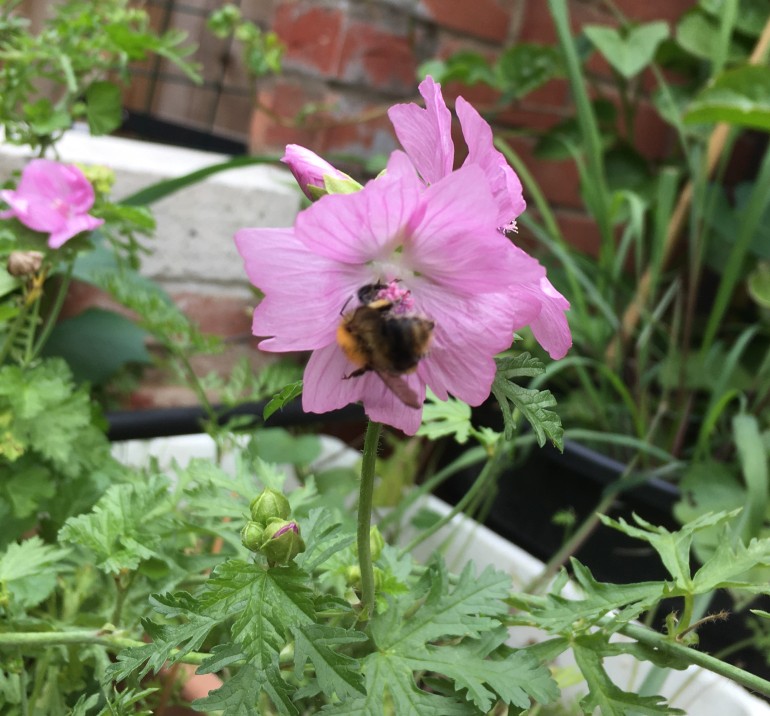Short version:
A tasty and attractive short lived perennial plant with unusual leaves and lovely large pink flowers. It can grow in almost all soil types and can tolerate some light shade.
Malva moschata or musk mallow is a relative of the better known marsh mallow, whose roots in times past were use to make the confections of the same name.
I started growing this after reading about it in ‘How to grow Perennial Vegetables’ by Martin Crawford. I’ll have to blog more on this book at a later date as I’ve found it to be an amazing resource. Out of the types he listed: hollyhocks, wood mallow, marsh mallow and musk mallow I found, at the time, the musk mallow seeds the easiest to purchase. All mallows are supposed to edible (but don’t eat them unless you’re sure of your identification and do your own research to check that the specific one that you’re eating is definitely edible) but I think only these ones are listed because the others are biennial or annuals.
How to grow
These can be grown from seed either in autumn or in spring. If growing these for the first time I’d suggest sowing in a pot indoors if possible, to help with identification when the seedling appears. It can then be planted out after frosts. I originally sowed mine in autumn and kept it indoors through the winter where it grew fairly slowly. It then was a strong little plant in the spring.
It can tolerate all types of soil but prefers a moist soil that drains well. I’ve read that it should NOT be fertilised as it can accumulate harmful levels of nitrates in the leaves. Apparently, it is the same with lettuces. It likes full sun but can tolerate light shade. Ours are in a pot which only gets sun from about 1pm onwards and they’re happy.

all musk… 
…mallow… 
…leaves.
It has the strangest leaves though. They become more divided as the plant flowers. This makes for interesting pressed leaves or sunprints (which I’ll do a blog on at some point too). In the set of pics of the flowers you can see all the different leaves.

sunprinting with leaves, musk mallow near the right 
the final result
The flowering period runs from July to September, but we have had some flowers in late June before.
It is an evergreen plant and will keep a few leaves at the base, even if the frosts come. However, it is a short-lived perennial but it does self-seed quite happily (even my voracious 5 year old doesn’t manage to eat ALL the flowers before they have a chance to set seed). You won’t notice the oldest plant has died if you have a few that are a year or so old filling in the gaps.
How to harvest
Help yourself to leaves and flowers as of and when they’re there. After flowering, the unripe seed pods can be eaten. I’ve read that they are called cheeses due to their shape. These only have a short window of opportunity before they ripen and become hard seeds. That isn’t a problem as it means you’ll be able to save seeds for next year or let it self seed.

The ‘cheese’, yup – tiny 
The seed pod if left forms beautiful cases 
The seeds 
hairs on the seeds to help them disperse
How they taste
I’ve been trying to grow a plethora of edible flowers. Edible is not synonymous with tasty. Things like artichoke buds are gorgeous steamed, borage makes a fun cucumbery snack, nasturtiums are tasty but a bit spicy when raw to eat many of, pansies have a wintergreen flavour (think ‘deep heat’ spray) and then there’s sunflower or dahlia petals which are nicely nutty but many varieties are bitter. Some taste like the rest of the plant, like brassica flowers or herb flowers. Some are just deeply bitter and I find it hard pressed to call them food, though they make a lovely garnish like fuchsias or Siberian purslane. I’m still growing fuchsia in the hope that one of the varieties I grow will produce tasty berries (all are edible but not all taste good).
Musk mallow is a delicate, beautiful flower that grows prolifically in season and tastes lovely raw. It has a lettuce like flavour so goes very well on top of salads or, as it happens in our garden, as a snack as soon as the petals open. If you’ve beaten the bees to it (and the bees do love it) you’ll also get a lovely sweetness to it. The flowers have a slight musky smell if you put your nose in close – hence the name. The musky smell is not noticeable when eating though.

opening bud 
happy bee 
white pollen grains
The leaves have a lettuce like taste again, but they also have a slightly mucilaginous feel which is probably why they can be used to thicken soups or stews.
The ‘cheeses’ taste slightly nutty.

flower salad 
little one did her own garnishing 
snack




One thought on “Musk mallow”